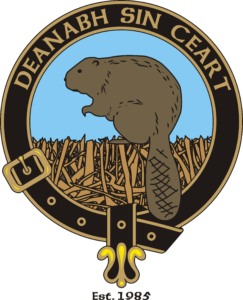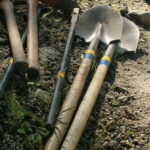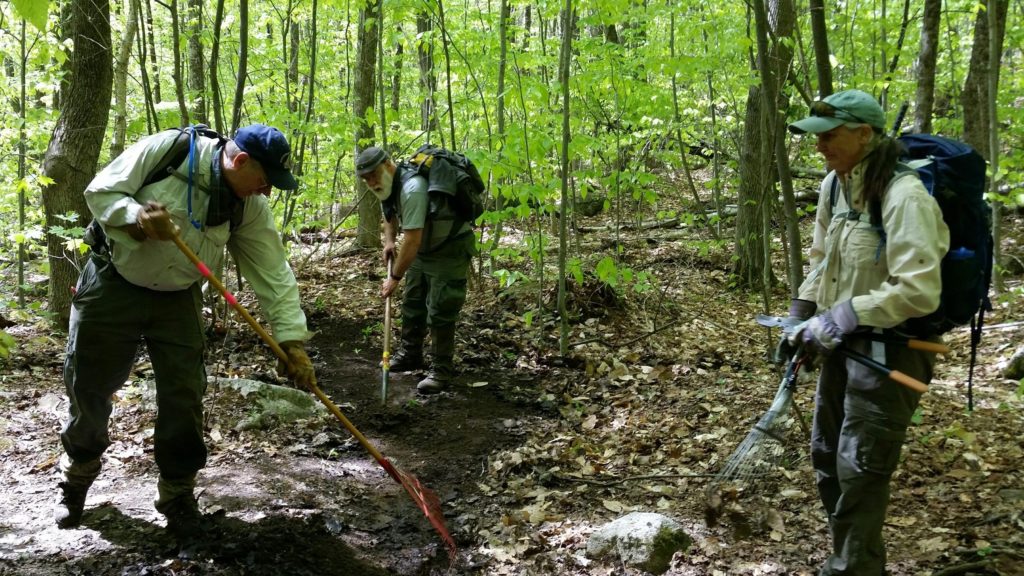Anatomy of a Spring Patrol
By Wes Tucker
Anybody who has spent time in New Hampshire knows that there are more seasons than just the basic four. The spring thaw is followed by mud season. Then fast on it's heels comes black fly season. But wedged in between them is a brief window of time that Cardigan Highlanders call spring patrol season. This is when we send crews out to walk the trails, assess how well they survived the winter, take care of minor problems, and identify major issues to be dealt with later in the year.
A spring patrol crew is usually 2-4 people carrying minimal tools in order to travel fast and light. Of course "fast and light" for a trail crew is a relative term. A typical patrol will have a 30" bow saw, 1 or 2 pruning saws, a lopper, a long handled shovel, 3 or 4 long nylon straps, and maybe a rock bar. Of course everyone has a pair of work gloves. When it comes to work gloves, everyone has a personal preference. Most of us go for the cheaper split leather and cotton type. We've found that the fancy expensive gloves don't last any longer than the inexpensive basic ones. Plus you don't feel so bad if they get caked with mud. Sun protection is also very important. The leaves on the trees are still just buds, so there is little between you and the springtime sun. Sunscreen, wide brim hats, long pants and sleeves are the uniform of the day.
Spring patrols will be starting up soon. They will be posted on the projects page if you would like to get involved.
The plan of the day could be patrolling a single trail. But when possible, you will head up one trail and descend another to make better use of your time. If you're lucky, and are patrolling on Mount Sunapee, the crew might catch a ride to the top on the ski lift so you're walking downhill all day. Whatever the case, the crew will walk along their assigned route looking for issues such as washouts, general erosion, and drainage issues. If any waterbars, ditches, and such are clogged with debris, they will get cleared out with a swipe of the shovel. Those needing more attention will be noted. You are also inspecting any bridges and rock stairways you come across.
Probably the most time consuming chore will be clearing blow-downs; trees that have come down across the trail over the course of the winter. A tree limb broken off by heavy snow can usually be taken care of with pruning saws or just muscle power to haul it off the trail. But when you come across an entire tree toppled by high winter winds, then it's time for the 30" bow saw. You can clear trees up to 10 inches in diameter with this simple tool. Of course it can't do it on its own. With some help from a rock bar applying force in just the right place, you keep the saw from getting pinched in the cut. Tag-teaming the sawyers prevents any one person from getting worn out. And maximizing leverage with a couple of nylon straps helps you to haul the larger pieces off the trail. This is how you make short work of it and continue on your way.
Occasionally you'll come to a blow-down that is just too big for the tools you have at hand. Its location gets noted for when a chainsaw crew can get there to clear it, but you don't just leave it at that. Often you can use pruning saws and loppers to trim off enough limbs to allow hikers to safely go over the tree and stay on the trail. Or you clear a safe alternate route so they can by-pass the obstacle and get right back onto the trail.
Between jobs you amble along the trail, no reason to rush, swap trail stories (even if you've heard them 5 times before), eat lunch, tell really bad jokes, maybe whistle a tune from times long past (yes that really happens). You continue on this way, going from task to task, and before you know it you're back at the trailhead. You clean off your tools and load them in the car. Change out of your muddy boots, maybe put on a clean shirt, and head to town for something cold to drink. All the while, you have a palpable feeling that you really accomplished something today.
This was reposted from April 2019 (with a little editing). Spring patrols will be starting up soon. They will be posted on the projects page if you would like to get involved. All are welcome, no experience required, just a willingness lend a hand.


